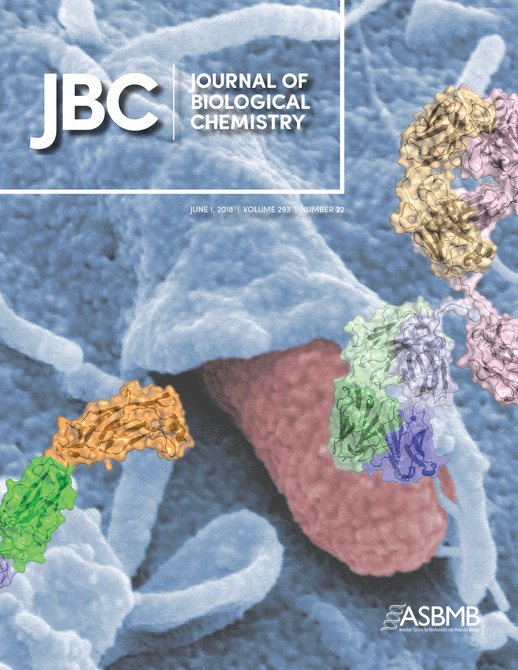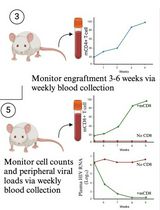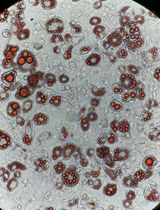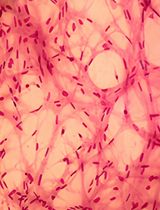- EN - English
- CN - 中文
In vivo Mouse Mammary Gland Formation
小鼠体内乳腺形成
发布: 2020年07月05日第10卷第13期 DOI: 10.21769/BioProtoc.3667 浏览次数: 4102
评审: Pilar VillacampaAnonymous reviewer(s)
Abstract
For years, the mammary gland serves as a perfect example to study the self-renew and differentiation of adult stem cells, and the regulatory mechanisms of these processes as well. To assess the function of given genes and/or other factors on stemness of mammary cells, several In vitro assays were developed, such as mammospheres formation assay, detection of stem cell markers by mRNA expression or flow cytometry and so on. However, the capacity of reconstruction of whole mount in the cleared fat pad of recipient female mice is a golden standard to estimate the stemness of the cells. Here we described a step-by-step protocol for in vivo mammary gland formation assay, including preparation of “cleared” recipients and mammary cells for implantation, the surgery process and how to assess the experimental results. Combined with manipulation of mammary cells via gene editing and /or drug treatment, this protocol could be very useful in the researches of mammary stem cells and mammary development.
Background
As one of the most typical organ of mammals, the mammary gland (MG) is an exocrine gland and responsible for lactation. The development of MG is under the control of certain sexual hormones, whose levels precisely regulate the structure, cellular composition and functional changes of MG in different developmental stages (Hennighausen and Robinson, 2005). Many genetic and environmental factors are involved in the regulation of mammary stem cells and the MG development. To study the functions and mechanisms of these factors, several methods have been developed, especially for the assessment of stemness of mammary cells. Previous studies demonstrated that only the basal cells instead of luminal cells of MG are able to reconstruct the epithelial tree in the cleared fat pads of recipient female mice, indicating the mammary stem cells only exist in the basal lineage (Van Keymeulen et al., 2011). Later, many studies including ours, uncovered several markers for mammary stem cells (Prater et al., 2014; Wang et al., 2015; Sun et al., 2018), whose function in stemness maintenance was confirmed by the in vivo MG formation assay. In this protocol, we described in detail how to prepare the donor mammary cells, how to remove the endogenous epithelia from the fad pads of recipients female mice, how to perform the implantation, as well as how to assess the experimental results. Besides of verifying mammary stem cell markers, this protocol could be also very useful in other researches regarding mammary stem cells and mammary development when combined with manipulation of mammary cells via gene editing, gene overexpression or knockdown, and/or drug treatment.
Materials and Reagents
- 50 ml centrifuge tubes (Corning, catalog number: CLS430829 )
- 1.5 ml micro-tubes (Axygen, catalog number: MCT150-C-S )
- Pipette tips 10 μl, 200 μl and 1,000 μl (Axygen, catalog numbers: T-400 , T-200-Y and T-1000-B )
- FACS tubes (FALCON, catalog number: 352058 )
- 40 μm cell strainer (FALCON, catalog number: 352340 )
- Cell counting chambers (Nexcelom Bioscience, catalog number: CHT4-SD100 )
- 0.2 μm Nalgene syringe filter (Thermo Fisher Scientific, catalog number: 725-2520 )
- 50 ml syringe (TERUMO, catalog number: SS-50LE )
- 1 ml syringe without needle (TERUMO, catalog number: SS-01T )
- 27G x ½” needle (TERUMO, catalog number: NN-2713R )
- Microscope slides (Thermo Fisher Scientific, catalog number: J1801ASH )
- Cover glass (Thermo Fisher Scientific, catalog numbers: 102222 and 102240 )
- Three-month-old female FVB mice for preparation of donor cells (as donors, provided by Animal facility core, Faculty of Health Sciences, University of Macau)
- Three-week-old virgin female nude mice (as recipients, provided by Animal facility core, Faculty of Health Sciences, University of Macau)
- DMEM/F12 medium (Thermo Fisher Scientific, catalog number: 11330032 )
- Fetal Bovine Serum (FBS) (Thermo Fisher Scientific, catalog number: 26140079 )
- HBSS (Thermo Fisher Scientific, catalog number: 14140112 )
- Hydrocortisone (Sigma-Aldrich, catalog number: H0888 )
- Insulin (Sigma-Aldrich, catalog number: 91077C )
- EGF (Thermo Fisher Scientific, catalog number: PHG0313 )
- Cholera toxin (Sigma-Aldrich, catalog number: C8052 )
- Collagenase Type 3 (Worthington Biochemical Corporation, catalog number: LS004183 )
- Hyaluronidase (Sigma-Aldrich, catalog number: H3506 )
- Dispase II (Roche, catalog number: 0 4942078001 )
- Deoxyribonuclease I (Worthington Biochemical Corporation, catalog number: LS002145 )
- HEPES (1 M) (Thermo Fisher Scientific, catalog number: 15630080 )
- DPBS (Thermo Fisher Scientific, catalog number: 14190250 )
- 0.25% Trypsin-EDTA (Thermo Fisher Scientific, catalog number: 25200056 )
- 1x RBC lysis buffer (Thermo Fisher Scientific, catalog number: 00-4333-57 )
- EasySeq Mouse Epithelial Cell Enrichment kit (STEMCELL Technologies, catalog number: 19868 )
- Trypan blue (STEMCELL Technologies, catalog number: 0 7050 )
- Anti-mouse CD24-PE-Cy7 antibody (BD Biosciences, catalog number:560536)
- Anti-mouse CD29-APC antibody (Biolegend, catalog number:102216)
- DAPI solution (1 mg/ml) (Thermo Fisher Scientific, catalog number: 62248 )
- Albumin, Bovine (BSA) (VWR LIFE SCIENCE, catalog number: VWRV0332 )
- EDTA (0.5 M), pH 8.0 (Thermo Fisher Scientific, catalog number: AM9260G )
- DPBS (Thermo Fisher Scientific, catalog number: 14190250 )
- PBS Tablets (Thermo Fisher Scientific, catalog number: 18912014 )
- 2,2,2-Tribromoethanol (Sigma-Aldrich, catalog number: T48402 )
- 2-Methyl-2-butanol (Sigma-Aldrich, catalog number: 152463 )
- Ethanol (Sigma-Aldrich, catalog number: E7023 )
- Chloroform (Sigma-Aldrich, catalog number: C2432 )
- Acetic acid (Sigma-Aldrich, catalog number: A6283 )
- Carmine (Sigma-Aldrich, catalog number: C1022 )
- Aluminum potassium sulfate (Sigma-Aldrich, catalog number: A7210 )
- Xylenes (Sigma-Aldrich, catalog number: 214736 )
- DPX Mountant (Sigma-Aldrich, catalog number: O6522 )
- Implantation buffer (see Recipes)
- Anesthetics (Avertin, see Recipes)
- Carnoy’s fix buffer (see Recipes)
- Carmine-alum staining solution (see Recipes)
Equipment
- Sterile scissors and forceps
- Tapes (to restrain the mice)
- Wound closures applier (RWD, catalog number: 12020-09 )
- 9 mm wound clips (RWD, catalog number: 12022-09 )
- Warming pad (Lab Animal Technology Develop Co., catalog number: LAT-BW2 )
- Pipette
- Biosafety cabinet for cell culture work
- Chemical hood
- Centrifuge with adaptors for 50 ml centrifuge tubes and FACS tubes, for use at room temperature.
- EasySep Magnet (STEMCELL Technologies, catalog number: 18000 )
- Cell counter (Nexcelom Bioscience, model: Cellometer Auto 2000 )
- BD FACSAria III for cell sorting
- Leica-M165FC stereo microscope
- Magnetic stirrer (IKA, RH basic)
Software
- BD FACSDiva 6.1 for BD FACSAria III
- ImageJ
Procedure
文章信息
版权信息
© 2020 The Authors; exclusive licensee Bio-protocol LLC.
如何引用
Readers should cite both the Bio-protocol article and the original research article where this protocol was used:
- Sun, H., Zhang, X., Chan, U. I., Su, S. M., Guo, S., Xu, X. and Deng, C. (2020). In vivo Mouse Mammary Gland Formation. Bio-protocol 10(13): e3667. DOI: 10.21769/BioProtoc.3667.
- Sun, H., Miao, Z., Zhang, X., Chan, U. I., Su, S. M., Guo, S., Wong, C. K. H., Xu, X. and Deng, C. X. (2018). Single-cell RNA-Seq reveals cell heterogeneity and hierarchy within mouse mammary epithelia. J Biol Chem 293(22): 8315-8329.
分类
干细胞 > 多能干细胞 > 再生医学
细胞生物学 > 细胞移植 > 异种移植
您对这篇实验方法有问题吗?
在此处发布您的问题,我们将邀请本文作者来回答。同时,我们会将您的问题发布到Bio-protocol Exchange,以便寻求社区成员的帮助。
提问指南
+ 问题描述
写下详细的问题描述,包括所有有助于他人回答您问题的信息(例如实验过程、条件和相关图像等)。
Share
Bluesky
X
Copy link












